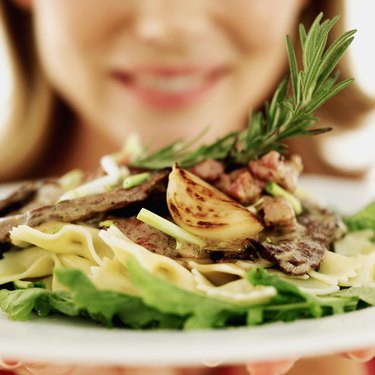
If you've decided to get rid of your lower stomach pudge, give yourself a pat on the back. That pooch isn't just effecting your appearance, it also has an impact on your health -- because belly fat, particularly visceral fat around your organs, is associated with health conditions, such as type-2 diabetes and heart disease. Before doing hundreds of crunches, understand that spot reduction is too good to be true, and to lose that stomach pudge, you must lose fat from your entire body.
Step 1
Incorporate dietary changes that result in a caloric deficit that triggers weight loss. For instance, eat smaller portions, skip desserts and fattening snacks, or replace high-calorie foods with low-calorie foods. Avoid foods that are high in salt, sugar, cholesterol, and saturated and trans fats. Emphasize lean protein, veggies, low-fat dairy, whole grains and fruit. Aim to lose one to two pounds per week by creating a daily deficit of 500 to 1,000 calories.
Video of the Day
Step 2
Perform 30 to 60 minutes of aerobic exercise on most days of the week to contribute to your caloric deficit. Go jogging, swimming, ride a bike or use cardiovascular exercise equipment, such as a stair climber or elliptical machine. Exercise at an intensity that still enables you to talk, but not sing.
Step 3
Incorporate resistance exercises into at least two days per week to maintain muscle tissue and to boost your metabolism. Exercise your arms, hips, back, abs, chest, shoulder and legs. Do eight to 12 repetitions of each exercise and work your way up to finishing two to three sets.
Step 4
Include abdominal exercises in your strength training routine. These exercises strengthen your stomach muscles, so that when your lower belly pudge reduces, a toned tummy is visible. Target the lower part of your rectus abdominis with the plank exercise, reverse crunches, and hanging knee or leg raises raises.
Step 5
Minimize stress in your life, because stress is associated with the release of cortisol in your body. This hormone increases your appetite, and when you give in and eat fatty, unhealthy foods, the fat you gain is mainly stored around your middle -- it's near your liver where it can be used in case you have another stress attack. Your body is trying to help and protect you by storing fat that it thinks you might need in the future. The cravings you get from high stress levels are only meant to fuel these fat stores. Meditate, get enough sleep every night, delegate tasks, take a yoga class or practice deep breathing.
Warning
See a doctor before beginning a new exercise routine or diet, especially if you have an injury or medical condition.
Video of the Day
- Harvard Medical School: Abdominal Fat and What to Do About It
- ExRx.net: Fat Loss & Weight Training Myths
- National Institutes of Health: Aim for a Healthy Weight
- U.S. Department of Health and Humane Services: Physical Activity Guidelines for Americans
- Fit Watch: The Top 3 Lower Ab Exercises
- Marilyn Glenville: How to Lose that Belly